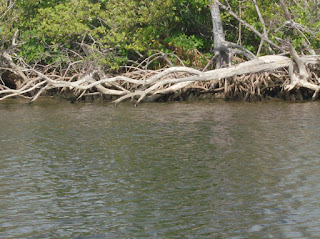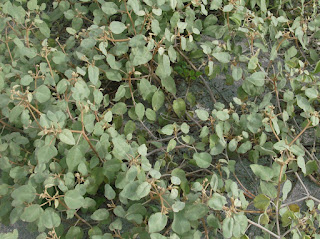Our day was spent at John U. Lloyd State Park, on the northern tip of Dania Beach. It is a beautiful beach - an example of a "real" Florida beach. The native plants are thriving there, due to the dilligence of a large number of volunteers and the staff of the park.  You can volunteer there to plant dune plants, like Sea Oats, and Mangroves.
You can volunteer there to plant dune plants, like Sea Oats, and Mangroves.
 You can volunteer there to plant dune plants, like Sea Oats, and Mangroves.
You can volunteer there to plant dune plants, like Sea Oats, and Mangroves.
During times of extreme weather here in South Florida, the native plants are essential to protection of the waters, coastline, and beyond.

In a hurricane, there might be a tidal surge. First, the coral reefs slow the surge down, then the water runs into the beach; if the dunes are healthy and stable, and secure with dune plants, the dunes will create a barrier to the tidal surge.

Next, the tides would encounter the Mangroves. Mangroves are an excellent blockade against high winds and high tides, and help prevent too much devestation beyond - where taller trees reside and where animal habitation is more prevalent.
The estuarine wetland helps prevent further damage, such as flooding - by absorbing the water into itself, possibly stopping it from flooding higher ground as much as possible.


Not only do plants have adaptations to help them in high winds and tidal surges, but many of them are adapted to fire as well. Florida is the lightning capital of the United States; Tampa Bay has more lightning than any other place in the United States. Africa has the most lightning of anywhere in the world.
With lightning comes fire. The trees and plants must be adapted in order to survive through hundreds of years of fires and storms.
 Our class began with a discussion and explanation of thunder and lightning and a brief talk of hurricanes. We found it fascinating that up above us -in the dark clouds, little ice cubes were bumping into each other creating an electrical current. The positive charges, or protons, float up, and the negative charges, or neutrons, move down. Then, just like everything in life, oppposites are attracted to each other- the protons try to get to the neutrons, and vice versa. Then, whammy! An explosion of light happens, which creates a HOLE in the air! We see the light and the hole closes in on itself, creating a large resonating BOOM - known as thunder. Since light is faster than sound, we see before we hear.
Our class began with a discussion and explanation of thunder and lightning and a brief talk of hurricanes. We found it fascinating that up above us -in the dark clouds, little ice cubes were bumping into each other creating an electrical current. The positive charges, or protons, float up, and the negative charges, or neutrons, move down. Then, just like everything in life, oppposites are attracted to each other- the protons try to get to the neutrons, and vice versa. Then, whammy! An explosion of light happens, which creates a HOLE in the air! We see the light and the hole closes in on itself, creating a large resonating BOOM - known as thunder. Since light is faster than sound, we see before we hear.We had been having mega thunder storms all that week, so we wanted to head out for our nature walk as soon as possible- before a storm greeted us. We packed up our water, nets and books and headed out. The morning class was happily inundated with Lubber Grasshoppers. One student noticed a large bright grasshopper and before we knew it we were surrounded.  They were everywhere, we just hadn't noticed. The kids and parents had a blast catching them, they are very slow and heavy for their size. One mom defied her long-carried fears and held one; she realized it wasn't so bad!!!
They were everywhere, we just hadn't noticed. The kids and parents had a blast catching them, they are very slow and heavy for their size. One mom defied her long-carried fears and held one; she realized it wasn't so bad!!!
 They were everywhere, we just hadn't noticed. The kids and parents had a blast catching them, they are very slow and heavy for their size. One mom defied her long-carried fears and held one; she realized it wasn't so bad!!!
They were everywhere, we just hadn't noticed. The kids and parents had a blast catching them, they are very slow and heavy for their size. One mom defied her long-carried fears and held one; she realized it wasn't so bad!!!
That evening, the Lubbers were no where to be seen, but instead we were honored with a view of a Florida Black Racer snake slithering by, heading to the shelter of the Sea Grapes. We continued down to Whiskey Creek, grabbed the nets and tried to find fish and crabs. After a long time of hunting, we did find a couple of crabs, one big one, one little one.
We ate Sea Purslane ( an important dune-creating plant) - what I used to call Sea Celery (it's also called Sea Pickle), to the delight and surprise of the kids and the moms.
 The purslane is extremely salty, succulent and crunchy. Sea Purslane is very high in vitamin C and has been used historically as a prevention to scurvy.
The purslane is extremely salty, succulent and crunchy. Sea Purslane is very high in vitamin C and has been used historically as a prevention to scurvy. 
We found a wonderful limestone rock and discussed the ancient bedrock of South Florida and its origins.


We walked up and across the path between the dunes, discussing their importance during extreme weather situations and how, here in South Florida, we are having more erosion now since we have bulldozed the dunes and mangroves.


We walked up and across the path between the dunes, discussing their importance during extreme weather situations and how, here in South Florida, we are having more erosion now since we have bulldozed the dunes and mangroves.
We spotted a Blue lined Racerunner ( a snazzy little lizard) running into the Sea Oats as we walked by and we observed how the horizontal roots of the sea dune plants stop the sand in it's tracks.

We headed down to the shore and looked through the bracken to see if we could find any critters. I never find much at the shore, everything burrows so quickly and gets out of sight.
Of course, the kids couldn't resist playing in the surf. They were in the water body surfing before we knew it. We dug in the sand, peeked under the sea weed - Sargassum seaweed that had made it's way to our shores from the sea of weeds, the Sargasso Sea, out in the Atlantic; and played tag with the waves.
They were in the water body surfing before we knew it. We dug in the sand, peeked under the sea weed - Sargassum seaweed that had made it's way to our shores from the sea of weeds, the Sargasso Sea, out in the Atlantic; and played tag with the waves.
 They were in the water body surfing before we knew it. We dug in the sand, peeked under the sea weed - Sargassum seaweed that had made it's way to our shores from the sea of weeds, the Sargasso Sea, out in the Atlantic; and played tag with the waves.
They were in the water body surfing before we knew it. We dug in the sand, peeked under the sea weed - Sargassum seaweed that had made it's way to our shores from the sea of weeds, the Sargasso Sea, out in the Atlantic; and played tag with the waves. 
I called everyone in and we reunited at the pavilion. It was time to make ice cream, or attempt to.

I had 2 large coffee cans and 2 small coffee cans, we filled the small ones with organic cream, vanilla extract in one and chocolate in the other, added sugar and mixed it all together. We placed the small can inside the large can, sealed it with duct tape, and put ice and rock salt on top. It was hard to do as the ice was too big and it was melting fast (it's hard to make ice cream in South Florida).
 Before we could add the ice, the kids took turns hammering it to try and crush it, they lined up ready to bang it out.
Before we could add the ice, the kids took turns hammering it to try and crush it, they lined up ready to bang it out.Then we sealed the top jar and the kids began kicking it around - the idea being that they would kick it enough so that it would cream up and freeze. Well, it didn't quite work that way. In the evening I had one our dads shake the vanilla for a long time while the kids kicked the chocolate one, the vanilla one was ALMOST ice cream while the chocolate one was slushy.

Some experienced moms and dads suggested that next time we leave an adult behind to start the process and then let the kids finish it off with the kicking, even doing two rounds of ice and salt to keep it frozen.
Regardless, it was DELICIOUS - organic, kid-made, and yummy! We ate it all up and the kids thought it was the best thing ever!
Thanks to my photographers!






No comments:
Post a Comment
Feel free to tell me what you think of the blog, I'd love to hear from you! Christy